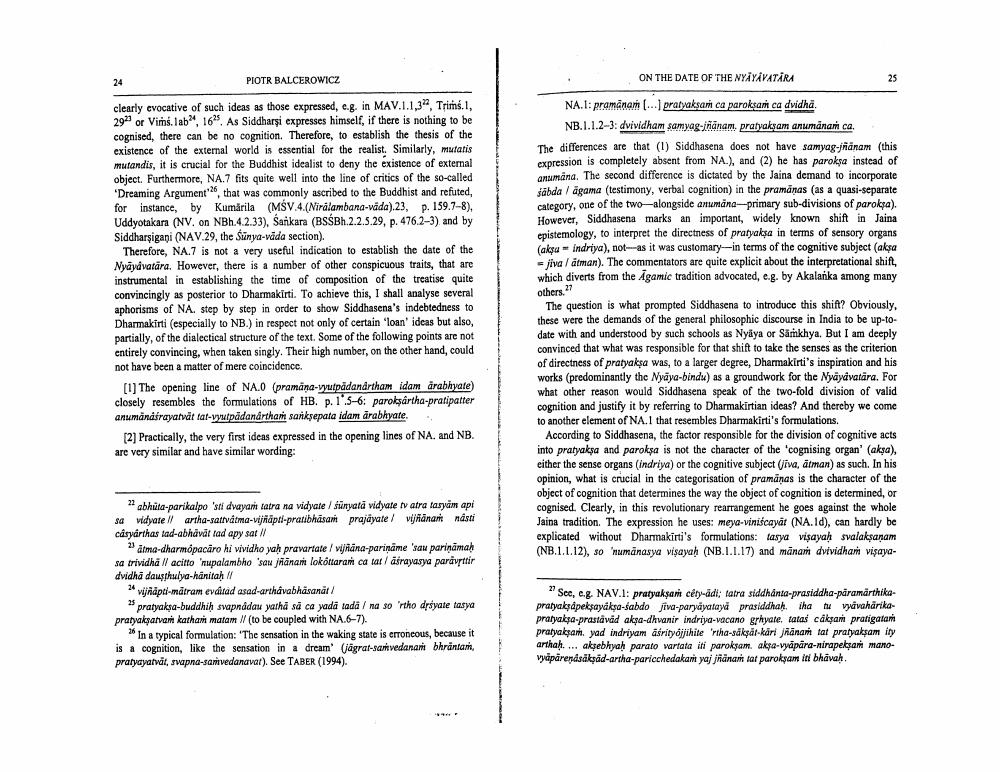Book Title: On The Date Of The Nnyayavatara Author(s): Piotr Balcerowicz Publisher: Piotr Balcerowicz View full book textPage 5
________________ PIOTR BALCEROWICZ ON THE DATE OF THE NYAYAVATARA 28 clearly evocative of such ideas as those expressed, c.g. in MAV.1.1,3, Trims. 1, 297) or viss.lab, 16*. As Siddharşi expresses himself, if there is nothing to be cognised, there can be no cognition. Therefore, to establish the thesis of the existence of the external world is essential for the realist, Similarly, mutatis mutandis, it is crucial for the Buddhist idealist to deny the existence of external object. Furthermore, NA.7 fits quite well into the line of critics of the so-called "Dreaming Argument that was commonly ascribed to the Buddhist and refuted, for instance, by Kumärila (MŠV.4.(Niralambana-vada).23, p. 159.7-8). Uddyotakara (NV. on NBh.4.2.33). Sankara (BSŚBh.2.2.5.29, p. 476.2-3) and by Siddharşigani (NAV.29, the Sunya-vada section). Therefore, NA.7 is not a very useful indication to establish the date of the Nyaydvatára. However, there is a number of other conspicuous traits, that are instrumental in establishing the time of composition of the treatise quite convincingly as posterior to Dharmakirti. To achieve this. I shall analyse several aphorisms of NA. step by step in order to show Siddhasena's indebtedness to Dharmakirti (especially to NB.) in respect not only of certain loan' ideas but also, partially, of the dialectical structure of the text. Some of the following points are not entirely convincing, when taken singly. Their high number, on the other hand, could not have been a matter of mere coincidence, [1] The opening line of NA.O (pramana-vyutadandrtham idam drabhyate) closely resembles the formulations of HB. p. 1.5-6: paroksártha-pratipatter anumandsrayatvdt tal-vwtddandrtham sanksepata idam arabhyate. [2] Practically, the very first ideas expressed in the opening lines of NA. and NB. are very similar and have similar wording: NA.I: pramanam ... pratyaksan ca parokcam ca dvidha. NB.1.1.2-3: dvividham samyag-inanam, pratyakşam anumanam ca. The differences are that (1) Siddhasena does not have samyag-janam (this expression is completely absent from NA.), and (2) he has paroksa instead of anumana. The second difference is dictated by the Jaina demand to incorporate šābda agama (testimony, verbal cognition) in the pramanas (as a quasi-separate category, one of the two-alongside anumang--primary sub-divisions of parokra). However, Siddhasena marks an important, widely known shift in Jaina epistemology, to interpret the directness of pratyaksa in terms of sensory organs (aksa indriya), notas it was customary-in terms of the cognitive subiect (aksa =jiva / atman). The commentators are quite explicit about the interpretational shift, which diverts from the Agamic tradition advocated, e.g. by Akalanka among many others.27 The question is what prompted Siddhasena to introduce this shift? Obviously, these were the demands of the general philosophic discourse in India to be up-todate with and understood by such schools as Nylya or Sarikhya. But I am deeply convinced that what was responsible for that shift to take the senses as the criterion of directness of pratyaksa was, to a larger degree, Dharmakirti's inspiration and his works (predominantly the Nyāya-bindu) as a groundwork for the Nydydyatára. For what other reason would Siddhasena speak of the two-fold division of valid cognition and justify it by referring to Dharmakirtian ideas? And thereby we come to another element of NA.I that resembles Dharmakirti's formulations. According to Siddhasena, the factor responsible for the division of cognitive acts into pratyaksa and paroksa is not the character of the 'cognising organ' (aksa), either the sense organs (Indriya) or the cognitive subject (jiwa, atman) as such. In his opinion, what is crucial in the categorisation of pramānas is the character of the object of cognition that determines the way the object of cognition is determined, or cognised. Clearly, in this revolutionary rearrangement he goes against the whole Jaina tradition. The expression he uses: meya-viniscayat (NA.Id), can hardly be explicated without Dharmakirti's formulations: tasya visayah svalaksanam (NB.1.1.12), so humanasya visayah (NB.1.1.17) and manam dvividhan visaya 13 abhita-parikalpo 'sti dvayan tatra na vidyate sünyata vidyate tv atra tasyum api 30 vidyote artha-sativdoma-vijäptl-pratibhasan prajayate / W anan ndsti cáspárthas tad-abhāvāt tad apy sat // 2) ama-dharmópacaro hi vividho yah pravartate / vijana-pariname 'sau parināmah sa trividha Ilacitto 'nupalambho sou jānan lokottaram ca tar / ásrayasya paravsttir dvidha dauskulya-hånitah vijñāpti-matram evdtad asad-arthavabhasanat / * pratyaksa-buddhih svapnådau yatha så ca yada tada / na so'rtho drsyate tasya pratyakarvan kathan matam 1 (to be coupled with NA.6-7). *In a typical formulation: 'The sensation in the waking state is erroneous, because it is a cognition, like the sensation in a dream agra v edanam bhrántani, pratyayardt, vapna-santvedanavar). See TABER (1994). - See, cg NAV.l: pratyaksan city-adi: tatra siddhanta-prasiddha-paramarthike pratyakrapeksayåksa-sabdo jiva-paryayalaya prasiddhan, iha t ydvahanikopratyaksa-prastavad akna-dhvanir indriya-vacano grhyate tatas cákra pratigatam prayaram yad indriyam asrityjjshitertha-sdikpat kari jänar tat prahyaksamity arthah.... aksebhyah parato vartata iti parokpam. akro-vapära-nirapetsam mano vapärendsäkpad-artha-paricchedakan yaj janart tar parokram ini bhavahPage Navigation
1 ... 3 4 5 6 7 8 9 10 11 12 13 14 15 16 17 18 19 20 21
